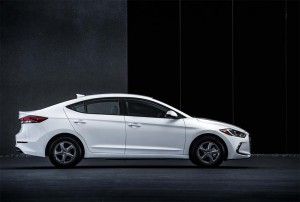Traditionally one of the least environmentally focused brands, Hyundai has been making a major shift towards more eco-friendly products over the last few years, and the 2017 Hyundai Elantra Eco is the latest example.
The all-new trim level takes the fuel economy of the Korean carmaker’s compact model up a big notch, boosting fuel economy to as much as 40 miles per gallon on the highway, with an EPA-certified city rating of 32 mpg and a combined 35 mpg.
Like other recent products, Hyundai has been putting more emphasis on things like performance, ride quality and refinement, but with the Elantra Eco, said product planning director Mike Evanoff, Hyundai “committed (itself) to delivering a compelling value proposition.”
(Mitsubishi admits it likely rigged mpg numbers on all Japanese models. Click Here for the latest.)
The sixth-generation Elantra has a tough act to follow, trying to build on the strongest-selling compact sedan Hyundai has ever offered. To enhance its appeal, Hyundai will now offer four versions, including the base Elantra SE, the premium Limited model, as well as the 2017 Hyundai Elantra Eco.
The latest addition to the line-up is powered by a 1.40-liter turbocharged inline-four making 128 horsepower and 156 pound-feet of torque. The Kappa engine sends power to the front wheels through a 7-speed dual-clutch gearbox tune specifically to enhance mileage.
With its 32/40/35 mile per gallon rating, the Elantra Eco delivers four more miles per gallon in the city than the SE model with an automatic transmission, and an additional two mpg on the highway. It has a three mpg higher combined rating. For someone who travels 15,000 miles a year, that would work out to around 430 gallons of gas annually, about 470 for the Elantra SE.
Whether consumers will flock to the Hyundai Elantra Eco remains to be seen, however. It’s the second-most expensive version of the compact sedan with a base price of $20,650. The SE with its 2.0-liter I-4 and a 6-speed manual gearbox starts at $17,150. Opt for a 6-speed automatic and that jumps $1,000. The Elantra Limited, meanwhile, starts at $22,350, including its bells-and-whistle standard equipment package.
(Automakers taking fire for bending the truth and outright lying. Click Herefor the story.)
Hyundai estimates that the increase in mileage will work out to an annual fuel cost of $950. However, other makers, such as General Motors, have found it difficult to win over customers willing to pay such a steep, initial premium hoping to save money over the long-term with reduced fuel bills. Hyundai has to hope that the Eco will gain more traction if and when gas prices spike again.
But the Eco model does offer more standard gear than the base sedan, including Blind Spot Detection, a 7-inch display audio system and both Apple CarPlay and Android Auto support.
Unlike other eco models, Hyundai says the Elantra version retains the same, already aero-efficient body as the rest of the compact sedan line. The key to its improved mileage is the powertrain. That includes an integrated cylinder head and exhaust manifold, as well as an optimized straight intake port to enhance combustion.
Drivers have the option of three operating modes: Eco, Normal and Sport.
All Elantra models are equipped with seven airbags and, like the other versions of the sedan, the Eco is expected to earn top safety ratings from both NHTSA and the IIHS.
(Safety, not profits, come first, says Transpo Sec Foxx, as Takata recall expands. Click Here for the story.)


